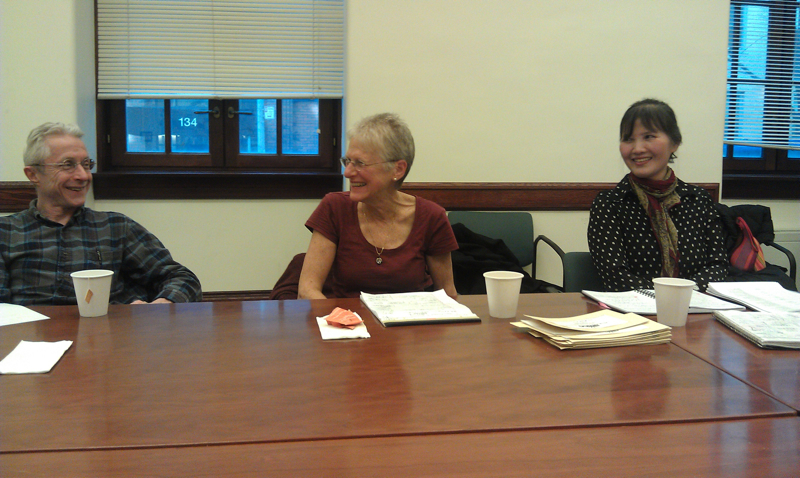I attended a lively meeting at Baruch College with this year’s cohort of Baruch Faculty Fellows shortly before the winter holidays. The Fellows had gathered to discuss the work they had accomplished during the Fall 2012 academic semester and to brainstorm future projects.
This year’s cohort of Fellows represents a rich array of academic expertise, including Art History, Comparative Religion, Mathematics, Sociology, and Business and Career Planning. Although some of these disciplines appear to be far removed from the art and cultural traditions of Himalayan Asia, much to my delight, three professors developed some really innovative curricular connections: Laurence Kirby, Susan Opotow, and Michelle Wang.
When Laurence Kirby, a professor of Mathematics at Baruch College, saw our collection of Tibetan Buddhist mandalas, he had a hunch that their beautiful symmetrical patterns would help his students understand the concept of symmetry in mathematics. Understanding symmetry is essential for the study of crystallography, the science of the structure of crystals. Crystallography, in turn, is vital for the study of proteins at molecular and atomic levels.
After a semester of working with our collections, including gallery visits and classroom discussions, not only did Professor Kirby’s students find mandalas as sacred cosmograms fascinating, it seemed that studying them did help them understand the concept of symmetry with more ease. One student was so intrigued by mandalas, she made two paintings with intricate symmetrical motifs on her own.
The first time Susan Opotow, a Sociologist at John Jay College of Criminal Justice, visited the museum, she was enchanted by the space’s physical beauty and sense of serenity. Dr. Opotow’s research focuses on individuals and social groups and how they experience different kinds of space. When she brought her students to the museum, she encouraged them to explore on their own, noting how they felt as they moved through the rooms. When asked to write reflective essays, Dr. Opotow discovered that rather finding the beauty of the museum inviting, some students found it intimidating, and were concerned that they might “do something wrong.” Those who met and spoke with roaming gallery guides, however, found the museum to be warm and inviting, indicating that human interactions are important for creating a sense of connectedness.
When Michelle Wang, who teaches Career Planning courses at Borough of Manhattan Community College, heard the story of the Buddha’s awakening, she turned to the mandala as a symbol exemplifying the Buddha’s quest for self knowledge. Over many weeks, I helped her design a workbook for her Career Planning students that includes assignments inspired by the Kalachakra Mandala (Wheel of Time). The assignments, which involve reflective writing and drawing exercises and visualizations techniques, were designed to help her students listen to their own inner wisdom to find a fulfilling job as opposed to following what someone else expected to them to do or to become.
Two more Fellows, Cristina Balboa, a Sociology professor from Baruch, and Toy-Fung Tung, an English professor at John Jay, shared their research projects for the Spring 2013 semester. Dr. Balboa would like to examine the Rubin as a place were different communities intersect through interviews with museum visitors. Dr. Tung is interested in exploring ancient pilgrimage routes, and how visits to museums are a form of modern-day pilgrimage. Wendy Raver, Lecturer in the Program in Religion at Hunter College, and Andrea Balis, Lecturer, History Department and Interdisciplinary Studies Program at John Jay, were unable to attend the meeting.



